Screening is one of the oldest of unit operations and is used in many industries worldwide. Many screening devices and a variety of screening surfaces are available in the marketplace. Choice depends on the size range involved, the nature of the application, the desired capacity, and the corresponding efficiency of the screen. Screen performance, which is measured in several ways, becomes important and is amenable to mathematical description. Most large-scale screening operations are continuous. Screen deck replacement and normal maintenance influence the operating expense, which is relevant to performance criteria.
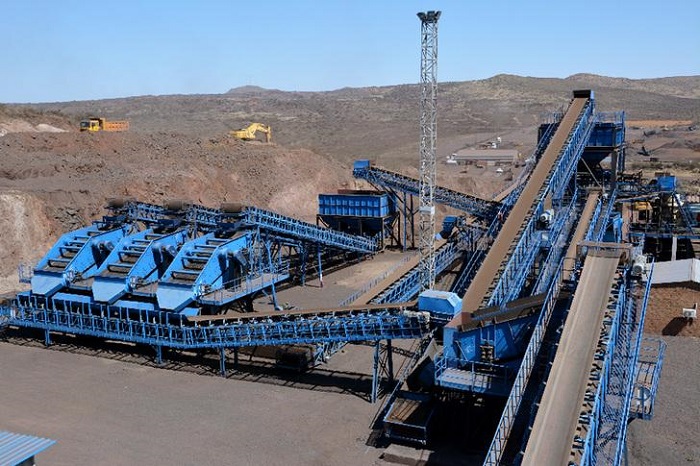
Classes of Screens
Industrial screens are categorized in Table 1 by mode of operation or motion; Photographs of typical vibrating screens encountered in the mineral industry are provided in Figure 1.
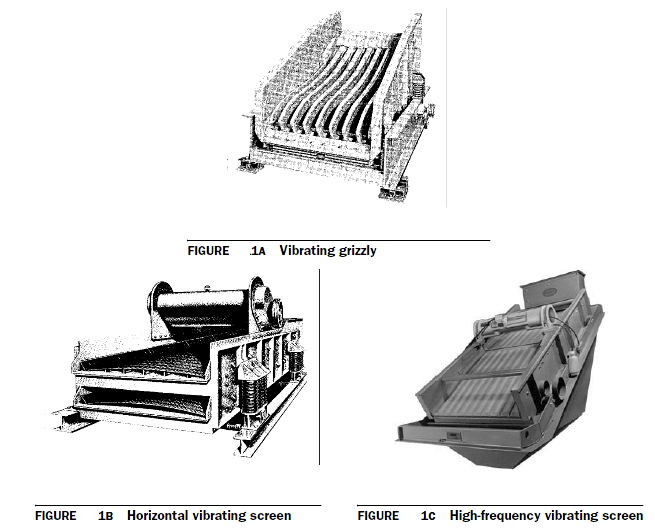
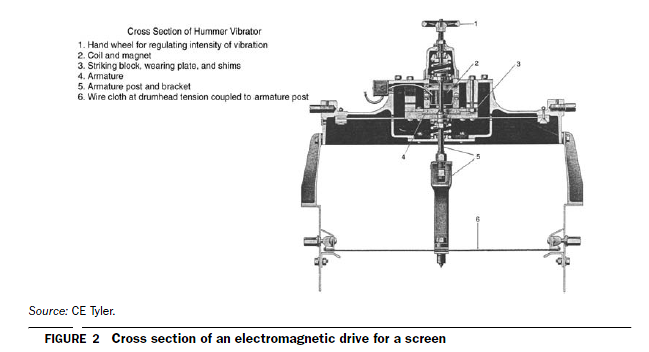
Major components of vibrating screen systems are the screening surface, the vibrating assembly, the base frame, the support frame, the vibrating frame, the motor or drive assembly, and the feed box or distributor. Auxiliaries include feed chutes, dust enclosures, conveyor belts, and dust collection systems.
Vibrating screens are widely used in crushing circuits that have either a mechanical or an electromagnetic drive arrangement. Figure 2 shows an electromagnetic drive section, and Table 2 summarizes ways in which mechanical vibration can be generated for various screening applications.
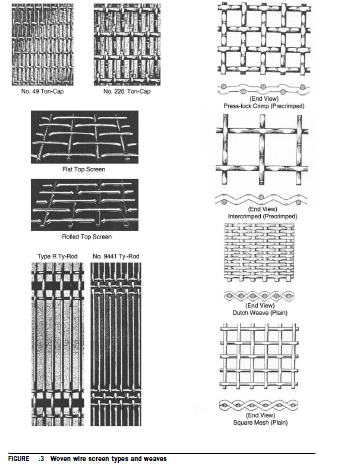
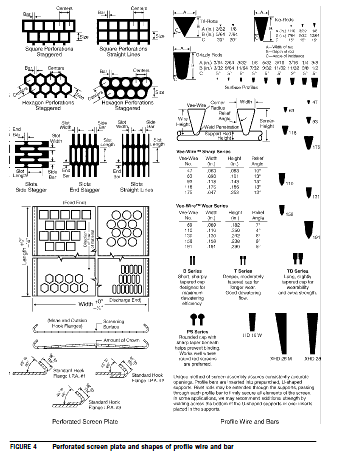
Screening Media
The most important element of any screen is the screening medium (the surface) where stratification and separation take place. Screening surfaces can be placed into one of three general categories: woven wire screen (cloth), perforated screen plate, and profile wire or bar. Figure 3 shows woven wire screen types and weaves in general use, and Figure 4 shows perforated plate and profile wire (or bar) shapes.
For very intensive use and coarse sizes, perforated plate is often employed, but when finer sizing is desired, profile wire is selected (Figure 4). Many materials have been used to make screen surfaces, including brass, copper, bronze, aluminum, monel, nickel, stainless steel, abrasion-resistant alloy steels, high-carbon steels, rubber, and synthetics such as reinforced polyurethane (tyrethane). A screen surface must withstand the stresses and loads applied to it and maintain a high degree of resistance to abrasion and corrosion. Once the aperture size and capacity characteristics are determined and a screen is fully operational, the “best” screen surface is one that never needs replacing. In practice, the goal is a minimal replacement cost per unit of throughput. For example, carbon steel screen is consumed at a rate as measured by a replacement cost of C dollars/ton/year. A synthetic material does not wear out as fast (perhaps lasting three or more times as long) but is more expensive to purchase. If C for the synthetic is greater, carbon steel will continue to be the material of choice.
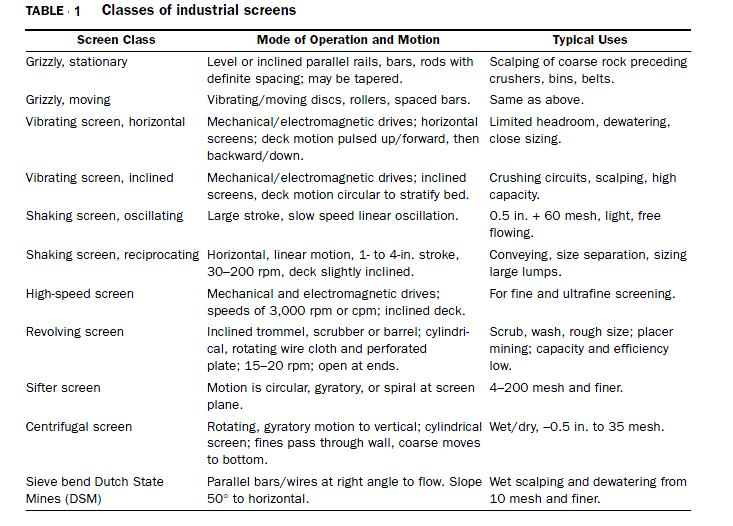
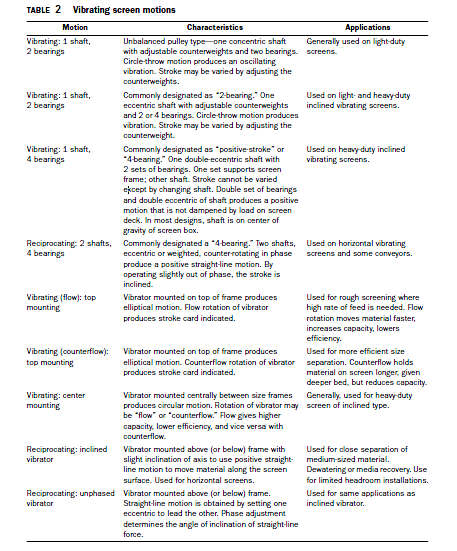
Square mesh surfaces are often selected for coarse applications if accurate sizing is necessary or if particles are slabby. However, on an incline the effective square mesh aperture and capacity may be reduced. On the other hand, rectangular mesh surfaces of comparable sizing will exhibit a higher capacity, because the proportion of open area is greater. Moreover, rectangular surfaces are not as susceptible to blinding (i.e., the plugging of openings with near-mesh particles or wet, sticky ones; the latter also cling to decrease the effective aperture) and are suited for needle-like particles, for highmoisture ores, and for ores with a high clay content. The flow of feed can be either parallel or perpendicular to the longer dimension of the mesh. Parallel flow of high-moisture or clayey ores allows a higher capacity and reduces blinding. Perpendicular flow of dry ore is less apt to blind screens, which then have a longer life and a higher efficiency. When blinding is severe, special screening decks should be considered. A heated deck is useful for fine, high-moisture ore. Ball decks rely on rubber balls bouncing against a screen bottom to loosen material. As a last resort, water sprays are recommended.
Perforated screen plates make coarse separations and are useful as an upper deck screen to reduce wear and damage to a lower deck screen of smaller aperture. Plates are more expensive, but they resist wear and have a long life, less blinding, higher efficiency, and a high degree of accuracy in sizing.
Screen openings of less than about 3/4 in. have an even smaller percentage of open area. An incline further reduces effective aperture.
Profile wire (rods or bars) has been used for coarse screening, for dewatering applications, and for special screen assemblies (such as cone shapes). Wire in parallel with the flow is most common, but transversely placed wire is effective for wet screening (e.g., the sieve bend) in the fine size ranges. Profile wire surfaces are not widely used in crushing circuits but may be used in grinding circuits to avoid producing slimes from friable ores.